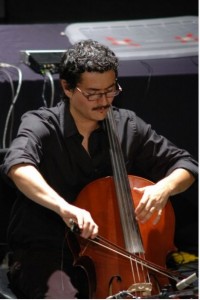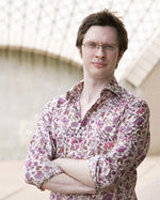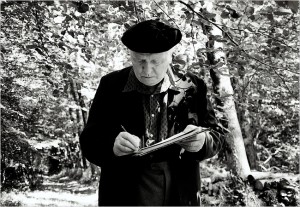Classical Music Review: It’s ‘Sick Puppy’ Time
By Caldwell Titcomb

Composer-percussionist Scott Deal
The annual enterprise’s acronym – SICPP – has engendered its colloquial nickname of “Sick Puppy.” The founding artistic director is the indefatigable NEC piano faculty member Stephen Drury (b. 1955), who oversees all the daily masterclasses, lectures, and workshops for the enrolled members.
The public face of the undertaking is a series of six free concerts Monday through Saturday in one of the NEC’s three auditoria. This year’s special composer-in-residence is the Briton Jonathan Harvey (b. 1939), seven of whose works are programmed for Wednesday, Thursday, and Friday.
I attended the opening concert on Monday, which offered music by five composers. First up was composer-percussionist Scott Deal, who holds music degrees from three institutions and is now a professor at Indiana University. He played his short and ebullient “Ester Parade” (2008), accompanied by an abstract video by Jordan Munson (also on the Indiana faculty) that emphasized the colors blue, green, and black. Munson’s “Shot and Abandoned” (2008), with a mostly green video, offered a series of objects that alternated with facial portraits that quickly vanished; Deal’s percussion playing here was restrained, and augmented by a computer tape. Deal’s own “Jackwalk” (2009) had him adding to the sonic mix a bass drum operated by a foot pedal. In all three pieces Deal exhibited phenomenal virtuosity.
Edgar Barroso (b. 1977), an experienced cellist, is a native of Mexico currently working toward a Ph.D. in composition at Harvard. His 13-minute “Logos” (2008) was, he says, based on the text “Against image. About Poetry and Philosophy” by the Mexican philosopher Santiago Espinosa, along with Aristotle’s definition of ‘logos’ as “argument from reason, one of the three modes of persuasion.”

Edgar Barroso at the cello

Composer Nicholas Vines
Lasting nearly a half hour, the difficult work is divided into three main sections: “Destruction,” “Desolation – Rejuvenation,” and “Regeneration.” It is scored for a chamber orchestra of three clarinets, two horns, four violins, two violas, two cellos, contrabass, and percussion. Drury conducted the somewhat flexible group known as the Callithumpian Consort, whose clarinets were not always sufficiently audible. The opening section proved really exciting. Later passages for vibraphone over soft sustained contrabass notes could stand some shortening. Especially striking was the periodic punctuation by whip-stick blows. The sizeable audience led the composer to take two bows.
There was one old work on the program – by old I mean written way back in 1943. This was the “Visions de l’Amen” by Olivier Messiaen (1908-92), a two-piano composition written for himself and his student Yvonne Loriod (who would later become his second wife). This is one of the supreme works of the 20th century. It lasts nearly an hour, and is divided into seven movements (Messiaen considered seven the “perfect” number). Roman Catholicism was never far from his music, which also drew on rhythmic techniques of Indian music as well as canons and palindromes from the Western tradition.

Composer Olivier Messiaen
The final “Sick Puppy” concert (in the NEC’s Brown Hall) will last at least six hours, and takes place on Saturday, June 20, beginning at 4 o’clock. This marathon occasion will offer music by at least two dozen composers – both famous and little known – and listeners are welcome to come and go as they please.
